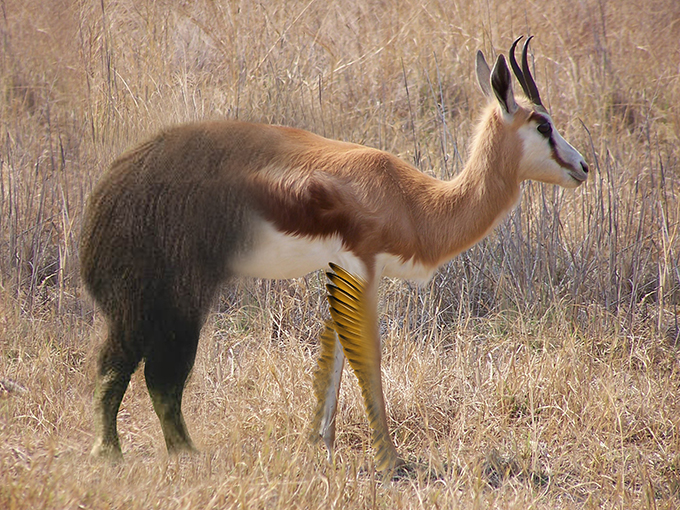Aepyncerus Syncalyra : Calygreyhound
| Kingdom: | Animalia |
| Phylum: | Chordata |
| Class: | Mammalia |
| Family: | Bovidae |
| Genera: | Aepyncerus |
| Species: | Syncalyra |
This creature ... must surely be one of the most curious beasts of heraldic invention. Unknown
The Calygreyhound
Gestation is generally 7-8 months, with both males & females reaching sexual maturity around 2 years. For the first few years, both sexes participate in mating, although offspring is rare until around 4-5 years. At 4-5 years, the males begin to fixate on a single female, often one they've mated with before, particularly if she has given birth (regardless of actual parentage of the offspring). It is the female who makes the final decision, however, dominating her chosen male with a show of 'dancing' in which she ultimately rubs all her feathers off onto her chosen male. Once this is accomplished, the female's feathers will grow back in much brighter colors and often in greater numbers. This has given rise to accounts in which the calygreyhound appears to have small wings, although this is of course not the case.
Territory & Feeding
A small creature, the calygreyhound is a herbivorous creature with a rather nervous disposition. With powerful back legs reminiscent of a bison, however, it's as likely to turn and deliver a smashing blow with its hindlegs as it is to simply gallop away from danger. Due to the weighty hindquarters it can't bound like an antelope, but what it lacks in leaping distance it makes up for with a powerful bucking kick. The calygreyhound tends to inhabit a relatively small territory, in loose herds of up to 20 individuals. These loose herds often cross paths with one another, especially during mating season, during which time the heavy grasses and bushes they feed on are largely stripped from the area.
While the herds do cross paths and mingle with each other throughout the year, smaller, closer-knit groups generally stay together regardless of their herd-mates. These smaller groups are most often comprised of a mated pair, with up to 4-5 younglings that have not yet formed mated bonds of their own. These smaller 'family' groups may disperse across a larger territory than the entire herd normally travels, particularly during a dry season.
Prey & Predator
Due to their heavy hindquarters, impeding leaping & high speed, and smaller size (about 3/4 the size of an antelope), the calygreyhound is a common target for most larger predators. Even hyenas will go after a lone calygreyhound, although even a lioness will be cautious of those powerful back legs. Their horns are not often used in defense, but there is some evidence that the feathers on their forelegs are not just decorative. Some reports indicate that the feathers are used as a means of distraction, both when the calygreyhound rears and lashes out with its forelegs and when the feathers are brushed against. The feathers are loosely attached and, much like a porcupine's quills, come out easily when brushed up against with some pressure. In fact, the feather shafts are much closer to a porcupine's quills than the shaft of a true bird feather. Once detached from the calygreyhound's leg, the end of the feather can be seen to have barbs, which attach to whatever pulled the feather out.

